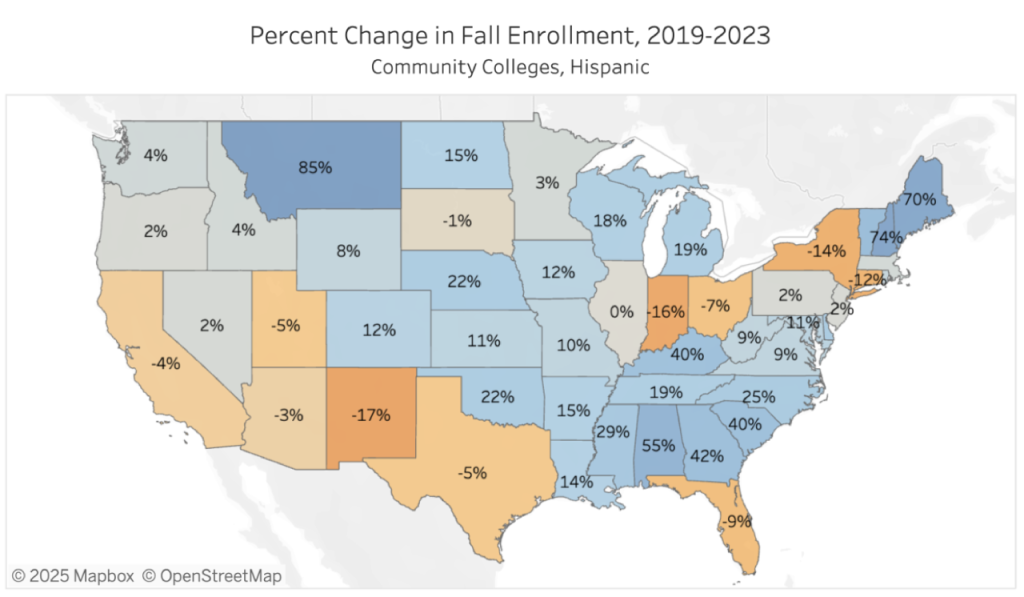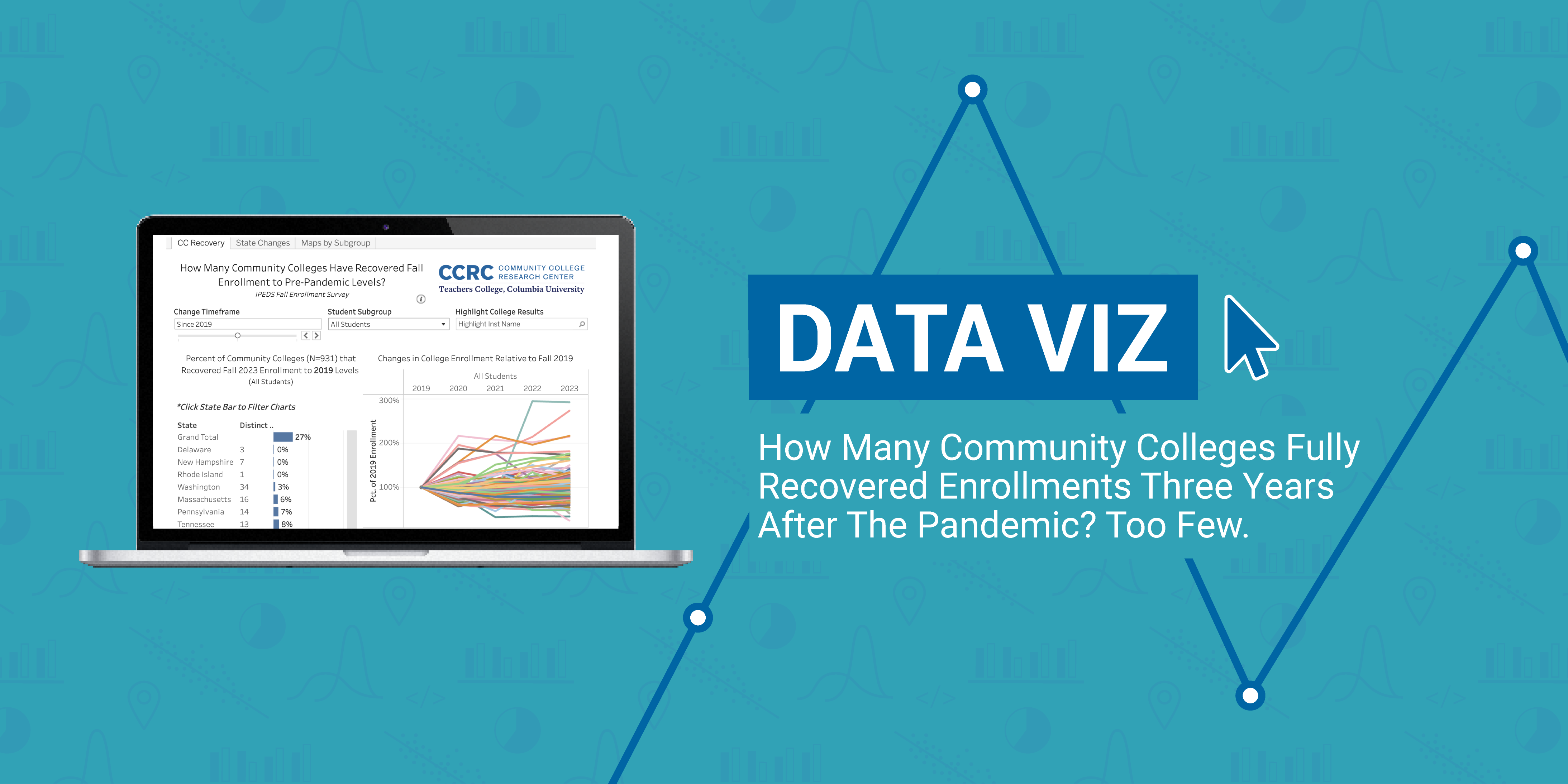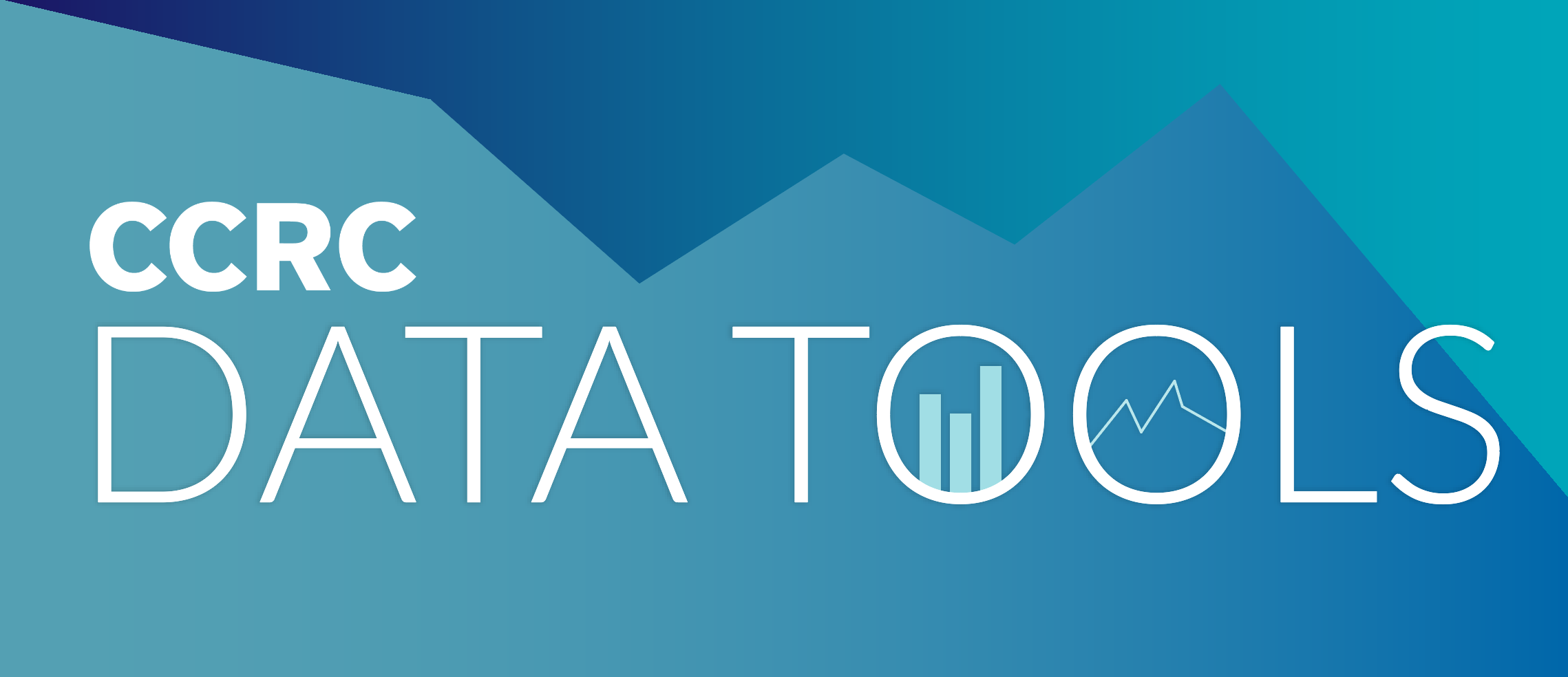Newly released fall 2023 enrollment numbers offer the most detailed look yet at how individual community colleges and state systems have fared since the onset of the COVID-19 pandemic. While there are clear bright spots when looking at individual colleges, student groups, and states, the overall national picture in the data from the federal Integrated Postsecondary Education Data System (IPEDS) is sobering: Only 27% of community colleges fully regained their enrollment levels from fall 2019 to fall 2023. And in seven states, fewer than 10% of community colleges restored enrollments to pre-pandemic levels.
Note: This analysis excludes Connecticut State Community College and Dallas College, which underwent community college mergers during this timeframe. The dashboard shows results for 931 community colleges nationally, including public two-year institutions and community colleges that award applied bachelor’s degrees, which are technically coded as public four-year institutions in IPEDS. See this post for more on our definition of community colleges.
In 2023, community college fall enrollment had climbed back above 6 million, up from the low point of 5.74 million in 2021, but not yet back to 2019 levels (6.59 million) and far below a decade prior (7.19 million in 2013). Contrary to this overall trend, the number of high school dual enrollment students (i.e., those under age 18) grew substantially throughout the pandemic, from 1.04 million in fall 2019 to 1.31 million in fall 2023, a 26% increase. While other subgroups by race/ethnicity and age showed some partial recovery from 2019 to 2023 (most notably Hispanic students), high school dual enrollment was the only net positive growth segment for community colleges during the pandemic.
Related Blog Post: Funding Community Colleges After HEERF Using newly released institutional data from IPEDS, this ARCC Network blog post examines the role of Higher Education Emergency Relief (HEER) funding in community college revenues relative to other federal, state/local, and tuition sources throughout the pandemic and what the end of HEER funding may mean for community colleges in the future.
In this post, I highlight some key takeaways from data dashboards we created that show IPEDS fall enrollment trends for colleges and states, with detail by student age and race/ethnicity. As shown in the map below, community colleges in 21 states experienced double-digit enrollment declines from 2019 to 2023 as they and their students struggled through the pandemic and its aftermath. By hovering over states, users can see the trendline. Users can also filter by student age and race/ethnicity subgroup, as well as adjust the timeframe and postsecondary sector.
How did enrollment change in states and colleges?
The dashboard shows meaningful differences between subgroups of students by age group and race/ethnicity that are worth further investigation. For example, nearly every state saw average declines in community college enrollment by older adults (those 25 or older). The only exception was South Carolina, where enrollment by older adults grew 6% from 2019 to 2023, driven by a strong rebound from 2021 to 2023 (and a large pre-pandemic decline, suggesting that by 2019 the state had already reached a low point). Similarly, the vast majority of states suffered declines in recent high school graduates (aged 18-24) enrolling in community colleges—in fact, only 18% of community colleges had fully recovered enrollments among 18-24-year-old students to 2019 levels. But in Maine, enrollment among recent high school graduates shot up 21% from 2019 to 2023. In recent years, Maine and South Carolina have received national attention for free tuition policies combined with a strong focus on expanding demand-responsive career-technical programs and strengthening the path from high school to college. This raises further questions about which policies and practices have been effective in building back college enrollments and what can be learned from states like Maine and South Carolina.
Change in Fall Community College Enrollments by State From 2019 to 2023: Under Age 18 (Dual Enrollment) and Hispanic Students


View enrollment trends by other subgroups on the dashboard.
Many states managed to grow enrollments among high school dual enrollment (under 18) and Hispanic students (see maps above). In fact, almost every state’s community colleges saw growth in dual enrollment through the pandemic, building on decades of steady increases in high school students taking community college coursework. The fact that dual enrollment grew in 72% of community colleges from 2019 to 2023, while only 18% of community colleges grew enrollments of 18-24-year-old students during the same timeframe suggests that there is an opportunity for community colleges to increase the “yield” of dual enrollment students and other high school students.
Many state’s community colleges also showed positive gains in Hispanic student enrollments in the same timeframe. Nationally, fall enrollment among Hispanic students almost fully recovered in 2023 (1.76 million) to 2019 levels (1.8 million). And, two thirds of community colleges nationally had fully recovered Hispanic fall enrollment. However, California, Florida, and Texas, three states with the largest Hispanic enrollments pre-pandemic, still have not fully recovered community college enrollments among Hispanic students in 2023 relative to 2019.
What challenges and opportunities are illustrated from the data?
Using the dashboards above and below, users can examine trends in fall and full-year headcount enrollment for their college and state.
As we have discussed in prior posts recent enrollment trends by subgroups highlight ongoing challenges community college have faced over the past two decades and especially during the pandemic. But they also suggest opportunities for building back enrollments. For instance, the growth of high school dual enrollment—now more than a fifth of community college enrollments and higher at many colleges—offer colleges an opportunity to grow the supply of future students. But to do so, colleges and their K-12 partners must take a more intentional approach to dual enrollment, such as by expanding outreach to underserved high schools and increasing access to quality dual enrollment coursework aligned to in-demand fields with embedded college advising.
The fact that enrollments of older adults were dropping severely even before the pandemic suggests that colleges need to fundamentally rethink how they recruit and serve adult students and workers. Finally, community colleges were losing enrollments among recent high school graduates before losing another 600,000 during the pandemic. Although community college enrollments among recent high school graduates modestly recovered from 2021 to 2023, there is much more room for growth. In 2023, fall enrollment among 18-24 year olds—the largest share of community college enrollments by age group—was the same as in the early 2000s.
Since the onset of the pandemic, state and college leaders have taken steps to build back enrollments and further strengthen community colleges, which are critical for fostering upward mobility and supplying talent for their communities through accessible and affordable postsecondary education. But to recover the losses, which were substantial even before the pandemic, colleges and states must ensure that the programs and courses they offer are worth the return on investment of resources and time. These new data from IPEDS reveal for the first time which colleges have had more success building back enrollments overall and by student age and race/ethnicity group.
Examining the practices of colleges that have been able to build back enrollments and produce strong outcomes will be a continuing focus of our research at CCRC. We encourage you to look up your local results, download and use the data from these dashboards, and use this information to better understand how community colleges and states can best address enrollment challenges as the sector continues to recover.





